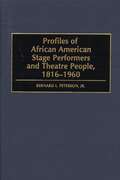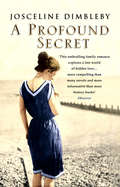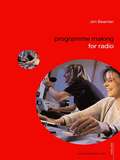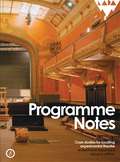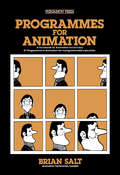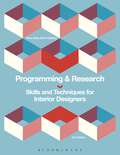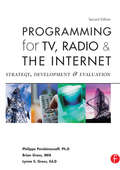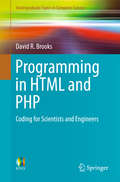- Table View
- List View
Profiles of African American Stage Performers and Theatre People, 1816-1960 (Non-ser.)
by Bernard L. Jr.This directory includes over 500 African American performers and theater people who have made a significant contribution to the American stage from the early 19th century to the beginning of the civil rights movement of the 1960s. Entries provide succinct biographical and theatrical information gathered from a variety of sources including library theater and drama collections, dissertations and theses, newspaper and magazine reviews and criticism, theater programs, theatrical memoirs, and earlier performing arts directories. Among the professional artists included in this volume are performers, librettists, lyricists, directors, producers, choreographers, stage managers, and musicians. The individuals profiled represent almost every major category and genre of the professional, semiprofessional, regional, and academic stage including minstrelsy, vaudeville, musical theater, and drama. Persons of historical significance are included as well as those stars and theatrical personalities that were well known during their time but who are relatively forgotten today.This comprehensive volume will appeal to theater and musical theater, Black studies, and American studies scholars. Cross-referenced throughout, this reference also includes an extensive bibliography and appendices of other theater personalities excluded from the main text. Separate indexes list the personalities, teams and partnerships, and performing groups, organizations, and companies.
Profiles of the Mannequin: The Cultural and Historical Impact of the Mannequin
by Eric FeigenbaumThey've been referred to as the quintessential silent sales force, but they are so much more than fancy clothes hangers. Mannequins breathe life, emotion, and animation into retail environments across the world. They are works of art that tap into the emotions and aspirations of all who engage with them. Profiles of the Mannequin tracks the history and evolution of these intriguing figures from the headless models of 1900 right up to today's virtual mannequins. Exploring shifts in representation of gender, race and body type, this study chronicles the connection between mannequins and movements in art, the humanities, current affairs, and fashion.Beautifully illustrated and engagingly told, fascinating in-depth interviews with creative professionals recount their experiences, philosophies, and stories of the mannequin and its impact on our culture as both a utilitarian object and as an artistic statement.Interviewees include: -Carol Barnhart, former owner and CEO, Carol Barnhart Inc.-Harry Cunningham, former Senior Vice President Store Planning, Design, and Visual Merchandising, Saks Fifth Avenue-James Damian, former President of Hindsgaul Mannequins USA-Paul Olszewski, former National Director of Windows and Internal Flagship Marketing, Macy's-Barbara Paris Gifford, Curator, Museum of Art and Design (MAD), New York-Ralph Pucci, mannequin designer, gallery owner and entrepreneur-Rob Smith, the CEO and Founder of the Phluid Project, the first gender-neutral store in the retail industry
Profiles of the Mannequin: The Cultural and Historical Impact of the Mannequin
by Eric FeigenbaumThey've been referred to as the quintessential silent sales force, but they are so much more than fancy clothes hangers. Mannequins breathe life, emotion, and animation into retail environments across the world. They are works of art that tap into the emotions and aspirations of all who engage with them. Profiles of the Mannequin tracks the history and evolution of these intriguing figures from the headless models of 1900 right up to today's virtual mannequins. Exploring shifts in representation of gender, race and body type, this study chronicles the connection between mannequins and movements in art, the humanities, current affairs, and fashion.Beautifully illustrated and engagingly told, fascinating in-depth interviews with creative professionals recount their experiences, philosophies, and stories of the mannequin and its impact on our culture as both a utilitarian object and as an artistic statement.Interviewees include: -Carol Barnhart, former owner and CEO, Carol Barnhart Inc.-Harry Cunningham, former Senior Vice President Store Planning, Design, and Visual Merchandising, Saks Fifth Avenue-James Damian, former President of Hindsgaul Mannequins USA-Paul Olszewski, former National Director of Windows and Internal Flagship Marketing, Macy's-Barbara Paris Gifford, Curator, Museum of Art and Design (MAD), New York-Ralph Pucci, mannequin designer, gallery owner and entrepreneur-Rob Smith, the CEO and Founder of the Phluid Project, the first gender-neutral store in the retail industry
A Profound Secret: May Gaskell, her daughter Amy, and Edward Burne-Jones
by Josceline DimblebyA chance encounter with Andrew Lloyd Webber at a summer party sent Josceline Dimbleby on a quest to uncover a mystery in her own family's past. Her great-aunt Amy Gaskell was the subject of a beautiful dark portrait by the Pre-Raphaelite painter Edward Burne-Jones, but all that was known about Amy, according to family lore, was that she had 'died young of a broken heart'.In her search, Josceline discovered a cache of unpublished letters from Burne-Jones to her great-grandmother May Gaskell, Amy's mother.They formed a passionate and prolific correspondence, of up to five letters a day, from the last six years of the painter's life. As she read, more and more questions were raised: why did Burne-Jones feel he had to protect May from an overwhelming sadness? What was the deep secret she had confided to him? And what was the tragic truth behind beautiful Amy's wayward, wandering life, her strange marriage and her unexplained early death?
Programme Making for Radio
by Jim BeamanProgramme Making for Radio offers trainee radio broadcasters and their instructors focused practical guidelines to the professional techniques applied to the making of radio shows, explaining how specific radio programmes are made and the conventions and techniques required to produce them. This book describes how and why these methods are applied through the use of a behind-the-scenes glimpse at working practices and procedures used in the industry. It considers the constraints and incentives that limit or stimulate creativity and innovation within programme production. Programme Making for Radio examines the individual roles and responsibilities of the whole production team and the importance of team-working skills. Chapters focus on the specific requirements of specialist programmes and offer advice from a range of programme makers working in local and national broadcasting. There is a case study example that follows the progress of a feature programme from pitching the original idea, through assembling material to final transmission. Programme Making for Radio includes: a clear description of the role of each member of the programme making team, their duties and responsibilities practical tips on interviewing, mixing and presenting explanations of the key elements that make up a radio programme such as clips, wraps, packages, features and interviews with a full glossary of technical terms. This book is informative, accessible and comprehensive, covering the whole range of skills needed by the radio professional in the studio and on location.
Programme Making for Radio
by Jim BeamanProgramme Making for Radio offers trainee radio broadcasters and their instructors focused practical guidelines to the professional techniques applied to the making of radio shows, explaining how specific radio programmes are made and the conventions and techniques required to produce them. This book describes how and why these methods are applied through the use of a behind-the-scenes glimpse at working practices and procedures used in the industry. It considers the constraints and incentives that limit or stimulate creativity and innovation within programme production. Programme Making for Radio examines the individual roles and responsibilities of the whole production team and the importance of team-working skills. Chapters focus on the specific requirements of specialist programmes and offer advice from a range of programme makers working in local and national broadcasting. There is a case study example that follows the progress of a feature programme from pitching the original idea, through assembling material to final transmission. Programme Making for Radio includes: a clear description of the role of each member of the programme making team, their duties and responsibilities practical tips on interviewing, mixing and presenting explanations of the key elements that make up a radio programme such as clips, wraps, packages, features and interviews with a full glossary of technical terms. This book is informative, accessible and comprehensive, covering the whole range of skills needed by the radio professional in the studio and on location.
Programme Notes: Case Studies for Locating Experimental Theatre
by Lois Keidan Cj MitchellProgramme Notes is a collection of commissioned essays, case studies and interviews reflecting the exciting and complex relationships between ‘mainstream’ stages and ‘experimental’ theatre practices. The first edition of Programme Notes, published in 2007, featured contributions by Lyn Gardner, Tim Etchells, Neil Bartlett, Stella Hall, John E McGrath, Alan Rivett, Mark Borkowski, Rose Fenton, Brian Logan, Lucy Neal, Keith Khan, Simon Casson, Louise Jeffreys, Judith Knight and Toni Racklin. This revised and expanded edition includes the original contributions whilst illustrating some of the seismic shifts that have taken place across the theatre landscape of the UK since 2007 through profiles of the work of Manchester International Festival, National Theatre of Scotland, BAC (Battersea Arts Centre) and Forest Fringe. Programme Notes features new contributions by Marina Abramovic, Alex Poots, Amanda Coogan, Vicky Featherstone, Mary Brennan, David Micklem, David Jubb, Andy Field and Deborah Pearson.
A Programme of Absolute Disorder: Decolonizing the Museum
by Françoise Vergès“A complete overhaul of the Western museum tradition”—Publishers Weekly“An impressive critique of the universal museum as complicit in the damages inflicted by colonial power”—Isaac Julien, artist and filmmaker“Should fascinate anyone interested in social justice, post-colonialism and the arts”—Euronews“Powerful and so relevant”—DiacritikThe Western museum is a battleground—a terrain of ideological, political and economic contestation. Almost everyone today wants to rethink the museum, but how many have the audacity to question the idea of the universal museum itself?In A Programme of Absolute Disorder, Françoise Vergès puts the museum in its place. Exploring the Louvre’s history, she uncovers the context in which the universal museum emerged: as a product of colonialism, and of Europe’s self-appointed claim to be the guardian of global heritage.Vergès outlines a radical horizon: to truly decolonize the museum is to implement a “programme of absolute disorder”, inventing other ways of apprehending the human and non-human world that nourish collective creativity and bring justice and dignity to the dispossessed.Françoise Vergès is a political scientist, activist, historian, film writer, and public educator. She is the author of A Decolonial Feminism and A Feminist History of Violence. She is also a senior research fellow at the Sarah Parker Remond Centre for the Study of Racism and Racialisation, University College London.
Programmes for Animation: A Handbook for Animation Technicians
by Brian SaltProgrammes for Animation: A Handbook for Animation Technicians is a handbook on animation containing a list of 57 programs for use on a programmable calculator. Each program is preceded by explanations of how the necessary mathematical formulas were derived; each step of the program is also accompanied by a brief explanation. The programs are intended for the Hewlett-Packard HP-97 calculator, and can also be used on the HP-67 pocket calculator.Comprised of 17 chapters, this book begins by giving sufficient information about the functions of the keys of the calculator. The discussion then turns to field widths and zoom counter readings; the field chart and coordinate systems; and lens and table off-sets. Subsequent chapters deal with linear movements and fairings; exponential movements; middle fairings and co-fairings; rotations and circular pans; and simple harmonic motion. Exposures at different field widths are also explained, along with zooms using several pieces of artwork and movements along a curve. The book concludes by describing two-lens aerial image projection. This monograph was written specifically for animation technicians.
Programmieren lernen mit Computergrafik: Eine Einführung mit Java und Processing
by Oliver Deussen Thomas NingelgenIm Zeitalter der Digitalisierung lädt dieses Buch dazu ein, das grundlegende Handwerkszeug der Computer-Programmierung zu erlernen. Motivierend und auch für Neulinge immer verständlich führen die Autoren in die wichtigsten Aspekte der Programmiersprache Java und die Programmierumgebung Processing ein. Leser lernen anhand grafischer Beispiele, wie sich kleine Spiele, Animationen, Fraktale oder Simulationen ohne viel Aufwand herstellen lassen. Alle Beispiele können auf einem Laptop realisiert werden. Einzige Voraussetzung ist, dass sich Processing installieren und ausführen lässt.Ausgehend von einfachen Bausteinen werden im Verlauf des Buchs immer kompliziertere Probleme gelöst und auf diese Weise die wichtigen Konzepte der Programmierung behandelt. Dabei holen die Autoren ihre Leser stets mit den passenden Worten ab: Ihre detaillierten Beschreibungen und Anleitung greifen genau die Fragen auf, die bei der Lektüre und beim Ausführen der Programmierbeispiele auftauchen können. Mit diesem Buch eignen sich Leser nicht nur die Grundfertigkeiten des Programmierens spielend an, sondern erhalten nebenbei auch noch einen tiefgehenden Einblick in die Funktionsweise von Computern.Die Autoren haben Processing als Programmierumgebung gewählt, weil man damit besonders gut veranschaulichen kann, worauf es beim Programmieren ankommt. Außerdem lassen sich mit dem Programm nicht nur Bilder und Animationen, Musik und Sounds erzeugen, Processing erlaubt auch die Interaktion mit dem Computer. Die Grundlagen der Programmierung für absolute Anfänger in einem Buch: von Algorithmen und Arrays bis Turtle-Grafik und Variablen.
Programmieren mit OpenGL: 3D-Grafik und Bildverarbeitung
by Ute ClaussenIn diesem Buch sind die verschiedenen Aspekte von OpenGL ausführlich dargestellt. Es ist in die typischen Themenbereiche der Computergrafik gegliedert. Von der Modellierung grafischer Szenen über Farbgebungen, Beleuchtung und Texturen bis hin zur Interaktion. Ein großer Abschnitt befaßt sich mit den Bibliotheken von OpenGL mit Ergänzungen oder Erweiterungen. Einerseits Version 1.1 und Open Inventor, andererseits aber auch die Bibliotheken zur Anbindung von Fenstersystemen, GLX für X-Windows und WGL für MS Windows. Dieses Buch will Sie auch zu eigenen Arbeiten anregen: Dazu hat die Autorin typische Beispiele für alle Bereiche und weiterführende Aufgaben bereitgestellt. Diese sind auch auf der beiliegenden CD-ROM als Windows95/WindowsNT-Anwendungen samt Quellen verfügbar.
Programming 101: Learn to Code with the Processing Language Using a Visual Approach
by Jeanine MeyerProgramming permeates almost all aspects of our lives. This includes being active on social media, shopping online, and participating in virtual courses. It also includes driving a car and using many devices. This book will teach you the basics of programming using the Processing programming language and provide practice with logical, algorithmic thinking. It can provide insight into what is involved in producing the technical infrastructure of our world. While reading this book, you can build programs based on your own ideas, using images you create or acquire and making connections to activities you enjoy. The chapters in the book will demonstrate the process of programming, starting with formulating an idea, planning, building on past projects, and refining the work, similar to writing an essay or composing a song. This approach will guide you to make use of logic and mathematics to produce beautiful effects. The text contains an Appendix with an introduction to p5.js, a way to produce JavaScript programs with Processing functionality for drawing, images, and interactions to publish on the Web. The term for program in Processing is sketch. The Processing language has been constructed by visual artists using the Java programming language as a base. However, the sketches featured in this book and typical in Processing are far more than static drawings; they incorporate interaction, animation, video, audio, and accessing files on the local computer and on the Web. Technical features are introduced and explained in the context of complete examples: games (Snake, Hangman, jigsaw, slingshot), making a collage of family images and video clips, preparing directions for folding an origami model, rotating objects in 3D, and others. Programming is a fun, creative, expressive pursuit. It does require attention to details and can be frustrating. Still, there is very little that compares to the satisfaction of building a program out of nothing and making it work (or taking an existing program and fixing a problem, or adding a feature and making it better). Programming 101 is your gateway to making this happen. What You'll Learn Gain basic programming skills Build fun and creative programs Use files for making a holiday card or a sequence of instructions Combine videos, images, and graphics in a Processing sketch Connections to other programming languages, most especially Java and JavaScript Who This Book Is For Anyone who has been thinking about trying programming, or has tried, but needs assistance. Anyone who wants to use their own creativity and artistic talents. Anyone who wants to know what is involved in the technology that is present in our lives. Anyone who wants to know what is involved in the technology that is present in our lives.
Programming and Research: Skills and Techniques for Interior Designers
by Rose Mary Botti-SalitskyProgramming and Research: Skills and Techniques for Interior Designers, Second Edition, provides a step-by-step approach to mastering the process of documenting client and user requirements for any design project. Replete with examples and analyses of student and professional work, this book guides its readers through the creation of their own program documents. Both the National Council for Interior Design Qualification (NCIDQ) and the Council for Interior Design Accreditation (CIDA) consider programming a required core of knowledge. Programming and Research focuses on how the study of programming for interior designers prepares students for and advances them into the professional realm.Features-More than 100 images, including student work, help illustrate and explain the programming process -Appendices include actual programming documents used by successful interior design firms, a residential questionnaire, and a list of helpful resources -Key terms are highlighted in the text and defined in a comprehensive glossary New to this Edition-Updated with new coverage on evidence-based design, integrated project delivery (IPD), building information modeling (BIM), design across disciplines, LEED programming, designing on a budget, and time management -New examples and case studies throughout cover new technological tools being employed in the industry to collect data -More intuitive integration of art and graphics to explanations in the text Teaching Resources-Instructor's Guide provides suggestions for planning the course and using the text in the classroom, supplemental assignments, lecture notes, and sample test questions -PowerPoint® presentations include images from the book and provide a framework for lecture and discussion
Programming.Architecture
by Paul CoatesProgramming.Architecture is a simple and concise introduction to the history of computing and computational design, explaining the basics of algorithmic thinking and the use of the computer as a tool for design and architecture. Paul Coates, a pioneer of CAAD, demonstrates algorithmic thinking through projects and student work collated through his years of teaching students of computing and design. The book takes a detailed and practical look at what the techniques and philosophy of coding entail, and gives the reader many "glimpses under the hood" in the form of code snippets and examples of algorithms. This is essential reading for student and professional architects and designers interested in how the development of computers has influenced the way we think about, and design for, the built environment.
Programming.Architecture
by Paul CoatesProgramming.Architecture is a simple and concise introduction to the history of computing and computational design, explaining the basics of algorithmic thinking and the use of the computer as a tool for design and architecture. Paul Coates, a pioneer of CAAD, demonstrates algorithmic thinking through projects and student work collated through his years of teaching students of computing and design. The book takes a detailed and practical look at what the techniques and philosophy of coding entail, and gives the reader many "glimpses under the hood" in the form of code snippets and examples of algorithms. This is essential reading for student and professional architects and designers interested in how the development of computers has influenced the way we think about, and design for, the built environment.
Programming for Health and Wellbeing in Architecture
by Keely Menezes A. Vernon Woodworth Pamela De Oliveira-SmithProgramming for Health and Wellbeing in Architecture presents a new approach to architectural programming that includes sustainability, neuroscience and human factors. This volume of contributions from noted architects and academics makes the case for rethinking the practices of programming and planning to incorporate evidence-based design, systems thinking and a deeper understanding of our evolutionary nature. These 18 original essays highlight how human and environmental health are closely related and should be incorporated as mutually reinforcing goals in every design project. Together, these chapters describe the framework for a new paradigm of building performance and design of the human experience. Programming—the stage at which research is conducted and goals established—provides an opportunity to examine potential impacts and to craft strategies for wellbeing in new buildings and renovations using the latest scientific methods. This book expands the scope of the programming process and provides essential guidance for sustainable practice and the advancement of wellbeing in the built environment for architecture and interiors students, practitioners, instructors and academics.
Programming for Health and Wellbeing in Architecture
by Keely Menezes MphProgramming for Health and Wellbeing in Architecture presents a new approach to architectural programming that includes sustainability, neuroscience and human factors. This volume of contributions from noted architects and academics makes the case for rethinking the practices of programming and planning to incorporate evidence-based design, systems thinking and a deeper understanding of our evolutionary nature. These 18 original essays highlight how human and environmental health are closely related and should be incorporated as mutually reinforcing goals in every design project. Together, these chapters describe the framework for a new paradigm of building performance and design of the human experience. Programming—the stage at which research is conducted and goals established—provides an opportunity to examine potential impacts and to craft strategies for wellbeing in new buildings and renovations using the latest scientific methods. This book expands the scope of the programming process and provides essential guidance for sustainable practice and the advancement of wellbeing in the built environment for architecture and interiors students, practitioners, instructors and academics.
Programming for TV, Radio & The Internet: Strategy, Development & Evaluation
by Lynne Gross Brian Gross Philippe PerebinossoffWhere do program ideas come from? How are concepts developed into saleable productions? Who do you talk to about getting a show produced? How do you schedule shows on the lineup? What do you do if a series is in trouble? The answers to these questions, and many more, can be found in this comprehensive, in-depth look at the roles and responsibilities of the electronic media programmer. Topics include: Network relationships with affiliates, the expanded market of syndication, sources of programming for stations and networks, research and its role in programming decisions, fundamental appeals to an audience and what qualities are tied to success, outside forces that influence programming, strategies for launching new programs or saving old ones. Includes real-life examples taken from the authors' experiences, and 250+ illustrations!
Programming for TV, Radio & The Internet: Strategy, Development & Evaluation
by Lynne Gross Brian Gross Philippe PerebinossoffWhere do program ideas come from? How are concepts developed into saleable productions? Who do you talk to about getting a show produced? How do you schedule shows on the lineup? What do you do if a series is in trouble? The answers to these questions, and many more, can be found in this comprehensive, in-depth look at the roles and responsibilities of the electronic media programmer. Topics include: Network relationships with affiliates, the expanded market of syndication, sources of programming for stations and networks, research and its role in programming decisions, fundamental appeals to an audience and what qualities are tied to success, outside forces that influence programming, strategies for launching new programs or saving old ones. Includes real-life examples taken from the authors' experiences, and 250+ illustrations!
Programming GPS and OpenStreetMap Applications with Java: The RealObject Application Framework
by Kristof BeiglböckWritten by an expert in the development of GPS systems with digital maps and navigation, Programming GPS and OpenStreetMap Applications with Java: The RealObject Application Framework provides a concrete paradigm for object-oriented modeling and programming. It presents a thorough introduction to the use of available global positioning data for the
Programming in HTML and PHP: Coding for Scientists and Engineers (Undergraduate Topics in Computer Science)
by David R. BrooksThis concise and accessible textbook will enable readers to quickly develop the working skills necessary to solve computational problems in a server-based environment, using HTML and PHP. The importance of learning by example (as opposed to simply learning by copying) is emphasized through extensive use of hands-on exercises and examples, with a specific focus on useful science and engineering applications. The clearly-written text is designed to be simple to follow for the novice student, without requiring any background in programming or mathematics beyond algebra.Topics and features: describes the creation of HTML pages and the characteristics of HTML documents, showing how to use HTML tables, forms, lists, and frames to organize documents for use with PHP applications; explains how to set up a PHP environment, using a local or remote server; introduces the capabilities and syntax of the PHP language, including coverage of array syntax and use; examines user-defined functions in programming, summarizing PHP functions for reading and writing files, viewing the content of variables, and manipulating strings; reviews the PHP GD graphics library, presenting applications for creating pie charts, bar graphs, and line graphs suitable for displaying scientific data; includes appendices listing HTML and ASCII special characters, and highlighting the essential basic strategies for solving computational problems.Supplying all of the tools necessary to begin coding in HTML and PHP, this invaluable textbook is ideal for undergraduate students taking introductory courses in programming. The book will also serve as a helpful self-study text for professionals in any technical field.
Programming Interior Environments: A Practical Guide for Students
by Cynthia M. KarpanProgramming Interior Environments introduces a four-component framework you can use to program interiors, and twelve methods for you to gather, analyze and synthesize programmatic information to take the guesswork out of your studio projects. This book studies the Student Programming Model: a realistic programming process for college and university interior design students that allows students to create accurate and in-depth programming documents essential for informing the design process. This is done whilst keeping in mind that students are often working solo, with imaginary clients and end users in mind, and collecting program information within strict time constraints. Including three appendices of student programs created following these guidelines, to help you understand how to apply the framework components and inquiry methods in your own work, this book is ideal for students and professionals in interior design and interior architecture.
Programming Interior Environments: A Practical Guide for Students
by Cynthia M. KarpanProgramming Interior Environments introduces a four-component framework you can use to program interiors, and twelve methods for you to gather, analyze and synthesize programmatic information to take the guesswork out of your studio projects. This book studies the Student Programming Model: a realistic programming process for college and university interior design students that allows students to create accurate and in-depth programming documents essential for informing the design process. This is done whilst keeping in mind that students are often working solo, with imaginary clients and end users in mind, and collecting program information within strict time constraints. Including three appendices of student programs created following these guidelines, to help you understand how to apply the framework components and inquiry methods in your own work, this book is ideal for students and professionals in interior design and interior architecture.
Programming Media Art Using Processing: A Beginner's Guide
by Margaret NobleProgramming Media Art Using Processing: A Beginner's Guide provides an entry-level exploration into visual design through computer programming using the open source and artist-friendly language, Processing. Used by hundreds of students, this learning system breaks lessons down into strategic steps towards fun and creative media art projects. This book provides a linear series of lessons with step-by-step examples that lead to beginning media art projects, including abstract designs, pixel landscapes, rollover animations, and simple video games. Computer programming can be overwhelming for the first-time learner, but this book makes the learning of code more digestible and fun through a full color, well-diagrammed, and deeply explained text presentation. Lessons are rhythmically broken down into digestible parts with code annotations and illustrations that help learners focus on the details one step at a time. The content is legible, flexible, and fun to work with because of its project-based nature. By following the lessons and producing the projects sequentially in this book, readers will develop the beginning foundational skills needed to understand computer programming basics across many languages and also explore the art of graphic design. Ultimately, this is a hands-on, practical guide. To learn more about Margaret Noble's work, please visit her artist's website and educator website.
